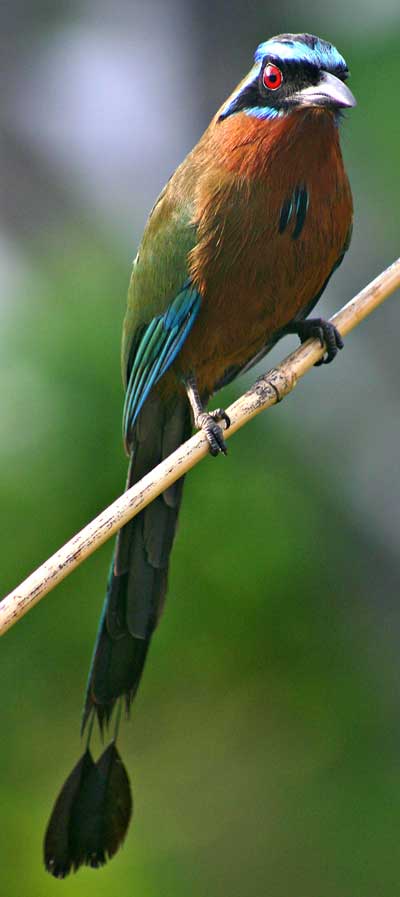
Momotus momota (*)
Superregnum: Eukaryota
Cladus: Unikonta
Cladus: Opisthokonta
Cladus: Holozoa
Regnum: Animalia
Subregnum: Eumetazoa
Cladus: Bilateria
Cladus: Nephrozoa
Superphylum: Deuterostomia
Phylum: Chordata
Subphylum: Vertebrata
Infraphylum: Gnathostomata
Megaclassis: Osteichthyes
Cladus: Sarcopterygii
Cladus: Rhipidistia
Cladus: Tetrapodomorpha
Cladus: Eotetrapodiformes
Cladus: Elpistostegalia
Superclassis: Tetrapoda
Cladus: Reptiliomorpha
Cladus: Amniota
Classis: Reptilia
Cladus: Eureptilia
Cladus: Romeriida
Subclassis: Diapsida
Cladus: Sauria
Infraclassis: Archosauromorpha
Cladus: Crurotarsi
Divisio: Archosauria
Cladus: Avemetatarsalia
Cladus: Ornithodira
Subtaxon: Dinosauromorpha
Cladus: Dinosauriformes
Cladus: Dracohors
Cladus: Dinosauria
Cladus: Saurischia
Cladus: Eusaurischia
Subordo: Theropoda
Cladus: Neotheropoda
Cladus: Averostra
Cladus: Tetanurae
Cladus: Avetheropoda
Cladus: Coelurosauria
Cladus: Tyrannoraptora
Cladus: Maniraptoromorpha
Cladus: Maniraptoriformes
Cladus: Maniraptora
Cladus: Pennaraptora
Cladus: Paraves
Cladus: Eumaniraptora
Cladus: Avialae
Infraclassis: Aves
Cladus: Avebrevicauda
Cladus: Pygostylia
Cladus: Ornithothoraces
Cladus: Ornithuromorpha
Cladus: Carinatae
Parvclassis: Neornithes
Cohors: Neognathae
Cladus: Neoaves
Ordo: Coraciiformes
Familia: Momotidae
Genus: Momotus
Species: Momotus momota
Subspecies: M. m. cametensis – M. m. ignobilis – M. m. marcgravianus – M. m. microstephanus – M. m. momota – M. m. nattereri – M. m. parensis – M. m. pilcomajensis – M. m. simplex
Name
Momotus momota (Linnaeus, 1766)
Synonyms
Ramphastos momota (protonym)
References
Primary references
Linnaeus, C. 1766. Systema naturae per regna tria naturae, secundum classes, ordines, genera, species, cum characteribus, differentiis, synonymis, locis (Regnum Animale). Editio duodecima (12th Ed.), reformata. Tomus 1 (Volume 1), Pars 1 (Part 1): 1–532. Holmiæ [Stockholm]. Impensis Direct Laurentii Salvii. Original description p.152 no.8 BHL Reference page.
References
Stiles, F. G. 2009. A review of the genus Momotus (Coraciiformes: Momotidae) in northern South America and adjacent areas. Ornitología Colombiana 8: 29–75. Full article (PDF).Reference page.
Links
IUCN: Momotus momota (Least Concern)
Vernacular names
English: Amazonian Motmot
español: Momoto amazónico
français: Motmot houtouc
português: Udu-de-coroa-azul
русский: Синешапочный момот
The Amazonian motmot (Momotus momota) is a colorful near-passerine bird in the family Momotidae. It is found in the Amazon lowlands and low Andean foothills from eastern Venezuela to eastern Brazil and northeastern Argentina.[2]
Taxonomy and systematics
The Amazonian motmot and the blue-capped (Momotus coeruleiceps), whooping (M. subrufrescens), Trinidad (M. bahamensis), Lesson's (M. lessonii), and Andean motmots (M. aequatorialis) were all at one time considered conspecific.[3][4][5] The Amazonian motmot has nine recognized subspecies; they are listed in the "Distribution and habitat" section below.[2]
Description
Close-up view of the head
The Amazonian motmot's plumage varies among the subspecies. The bodies of all are shades of green. All have a long tail that has extended feathers with racquet tips that are green or black. Most have a black eyemask, though their size and shape differ. The central crown is black and surrounded or partially bordered by a blue band. The nominate subspecies has a chestnut nape. Momotus momota ignobilis and M. m. cametensis have more extensive chestnut on the neck and face.[4]
Distribution and habitat
The Amazonian motmot is widely distributed in South America east of the Andes. Nine subspecies are recognized:[2]
Momotus momota momota — eastern Venezuela, Guyana, Suriname, French Guiana, and northern Brazil
M. m. microstephanus — southeastern Colombia, eastern Ecuador, and northwestern Brazil
M. m. ignobilis — eastern Peru and western Brazil
M. m. nattereri — northeastern Bolivia
M. m. simplex — western to west central Brazil south of the Amazon
M. m. cametensis — north central Brazil
M. m. parensis — northeastern Brazil
M. m. marcgravianus — eastern Brazil
M. m. pilcomajensis — southern Bolivia, southern Brazil, and northwestern Argentina
Throughout its range the Amazonian motmot inhabits the interior and edges of humid lowland forest. It is found up to 1,200 m (3,900 ft) in Venezuela, to 1,000 m (3,300 ft) in Ecuador, and to 750 m (2,460 ft) in Peru.[4]
Behavior
Feeding
The Amazonian motmot is omnivorous. It has been documented eating insects and other arthropods, small mammals and reptiles, and fruit.[4]
Breeding
Like most Coraciiformes, the Amazonian motmot nests in long tunnels in earth banks. Very little else is known about its breeding phenology.[4]
Vocalization
The Amazonian motmot's song has been described as "a fast, hollow hoo-do" and "a bubbling whOOP-oo"[1]. It also makes "a gruff kak", sometimes in a series.[2][4]
References
BirdLife International (2016). "Momotus momota". IUCN Red List of Threatened Species. 2016: e.T61634607A95173087. doi:10.2305/IUCN.UK.2016-3.RLTS.T61634607A95173087.en. Retrieved October 7, 2023.
Gill, F.; Donsker, D.; Rasmussen, P. (January 2021). "IOC World Bird List (v 11.1)". Retrieved January 14, 2021.
Remsen, J. V., Jr., J. I. Areta, E. Bonaccorso, S. Claramunt, A. Jaramillo, D. F. Lane, J. F. Pacheco, M. B. Robbins, F. G. Stiles, and K. J. Zimmer. Version 19 January 2021. A classification of the bird species of South America. American Ornithological Society. https://www.museum.lsu.edu/~Remsen/SACCBaseline.htm retrieved January 19, 2021
Orzechowski, S. C. and T. S. Schulenberg (2020). Amazonian Motmot (Momotus momota), version 1.0. In Birds of the World (T. S. Schulenberg, Editor). Cornell Lab of Ornithology, Ithaca, NY, USA. https://doi.org/10.2173/bow.bucmot4.01 retrieved May 5, 2021
Stiles, F. Gary (2009). "A review of the genus Momotus (Coraciiformes:Momotidae) in Northern South America and adjacent areas" (PDF). Ornitología Colombiana. 8: 29–75. ISSN 1794-0915. Retrieved May 5, 2021.
Retrieved from "http://en.wikipedia.org/"
All text is available under the terms of the GNU Free Documentation License

